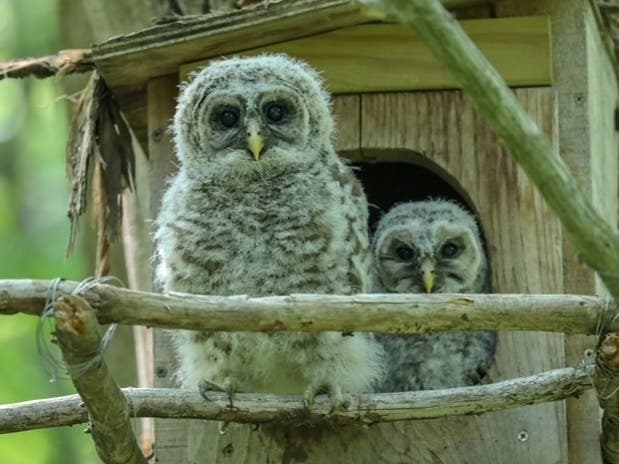Community Corner
Ridgefield Backyard Owls Drawing A Crowd On YouTube
Two 24/7 live feeds from a Ridgefield backyard are giving YouTube viewers what they crave: a peak into the secret life of owls. Who knew…?

RIDGEFIELD, CT — You can keep your bad haircuts, autotune vocals and duck-faced profile shots — Ridgefield's biggest internet star is a mama owl.
Living large in a nesting box built in his backyard by Ridgefield resident Michael Kralik, the barred owl's exploits have attracted a devoted following on two live 24/7 YouTube channels.
She has been giving the people what they want for "maybe five or six years or seven years or so," Kralik said, with surveillance of the exterior of the owl nesting box, but up until last year Owl Mom's had a modicum of privacy. This season, Kralik added a second, interior, camera to the production. Both feeds have about 900 subscribers, and the amateur videographer keeps the cameras rolling with PayPal donations from owl fans.
Find out what's happening in Ridgefieldwith free, real-time updates from Patch.
The egg-laying season is prime viewership time for Owl TV. Barred owls have one brood a year, and that begins in March. Ridgefield Owl Mom laid her first 2023 egg on March 19, and it hatched April 20. Her second hatchling checked in two days later, Kralik said.
Barred owls will lay two to three eggs annually, and that's been the pace for the owl in Kralik's backyard, for the most part. But when Ridgefield Owl Mom dropped four in 2022, her fan base flipped out.
Find out what's happening in Ridgefieldwith free, real-time updates from Patch.
"They are addicted to this kind of stuff, and they watch the cameras all day, and they'd never seen four eggs," Kralik said.
Lately, the big ratings have been for the baby owls' "branching."
"That's where they jump out of the box for the first time, and then they kind of walk up the trees. Basically, they'll walk around and use their beak to lift themselves up. And a lot of them fall down to the forest floor. That's very common," Kralik said. "And then they'll climb up a smaller tree and then make their way up into the canopy, with the mom always real close watching, every step of the way."

Kralik said he used to do a lot of spear fishing and underwater videography in Montauk, NY, but marriage mandated a change to that lifestyle. He switched to closer and drier subjects, such as bears, bobcats and birds, and was inspired by a buddy who created a YouTube channel for an osprey nest.
His sons, ages 5 and 3, make a point of tuning in to Owl TV each morning. The nest's YouTube channels have been a perennial favorite show-and-tell subject at St. Mary's where the children go to school, and at Greens Farms Academy in Westport, where Kralik's wife is an administrator.
Barred owls are very common in Connecticut, according to the Sharon Audubon Center. They are also widespread throughout the Eastern and Midwestern United States, as well as in the Northwestern states such as Washington and Oregon, and in Canada. Their preferred hunting grounds are dense conifer or mixed coniferous and deciduous forests, wooded swamps, and river valleys.
Barred owls eat mostly mice, but also indulge in smaller birds, rabbits, squirrels, rabbits, amphibians, reptiles, and insects. It's that diet high in varmints that gets the birds in trouble. Kralik said he has seen owls fall out of trees, killed instantly after eating a mouse which had consumed some rodenticide laid out by another homeowner. He encourages his Ridgefield neighbors to steer clear of the poisons and just "let the owls do their thing."
The birds aren't small, as befits their tier in the winged predator pecking order. Strix varia can weigh over 2 pounds, with a wingspan as wide as 4 feet and a height of 2 feet. They'll live 10 to 15 years in the wild, and up to twice that in captivity. Despite the size of the birds and the relative size of their population, people don't typically encounter the night birds who make their backyards their home, and the owls like to keep it that way.
If you are lucky enough to see an owl in your backyard or neighboring woodlands, be sure to keep your distance. And whatever you do, don't feed it. According to the Connecticut Audubon Society, once owls associate humans with food they are drawn into dangerous situations, such as swooping close to roads. The birds may also later approach people who will harm them, out of ignorance or malice.

Get more local news delivered straight to your inbox. Sign up for free Patch newsletters and alerts.